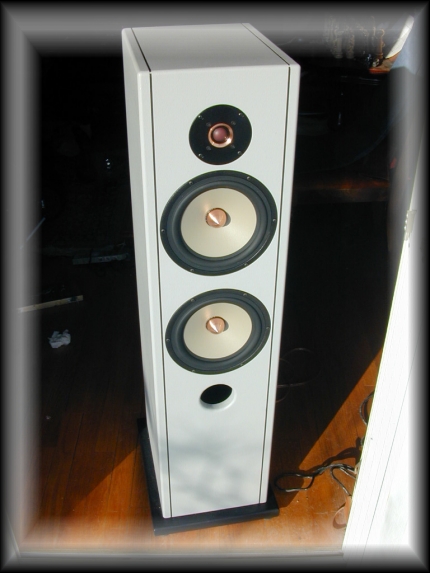A R C O S
X
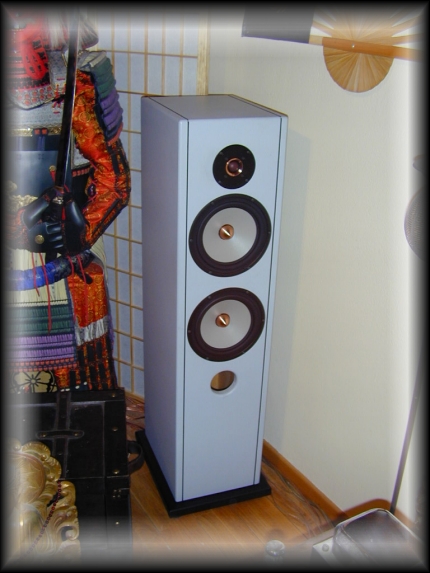

A useful overview..
The idea of the MTZ audio top
floor-standing speaker was introduced just before July 2005. Our initial advisors were
colleague-diyers, owners of our previous speaker projects (such as Mylo, Nimiel and Arcos
with Audax drivers). For all of us it was more than clear that this speaker should
outperform the simple notion of a 'massive speaker driving with excessive ease rooms
between 25 and 50 sq.m.'. Instead it should bear a unique performance in terms of
soundstage.
In fact it should reconstruct musical
action with not only the truthfullness of planar speakers but the unbeatable precision of
directional sound source. In addition this 'precision' should withstand the deficiencies
of any listening room.
Those that systematically deal with
speaker design, do know very well that a 'perfect SPL response curve' would not fulfill
the initial idea.
A couple of months later we became
aware that the flawless mechanical perfection and quality of the top Seas drivers, namely
the Excel drivers, would be able to support all our design principles throughout the
various project steps.
Thus it was the famous 8-inch W22EX001
woofer that was selected for its magnesium cone and the large voice-coil (39mm).
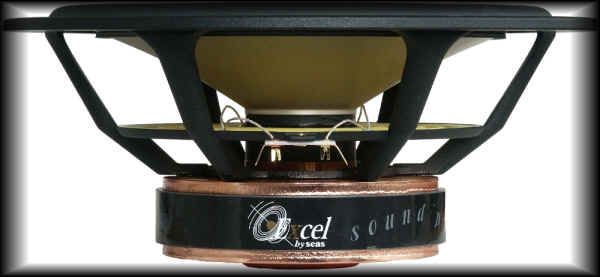
The main feature of this driver is its
'freely' suspended spider, delivering a symmetrical air load to the voice coil and
outstanding linearity to very low frequency reproduction. Seas lab measurement of
nonlinear distortion are indeed extremely low for this driver.
The very first listening sessions
validated our choice and unveiled unexpected clarity and transparency even at
extremely high SPL.
On the other hand the high frequency
driver was supposed to be able to maintain linearity and lack of colouration at very high
electrical and thermal load. In addition it should exhibit increased directivity, a key to
high fidelity sound reproduction in typical residential environment.
It is our belief that all these were
luckily 'more than easy' targets for the well known Seas 'millenium' tweeter (T25CF002).
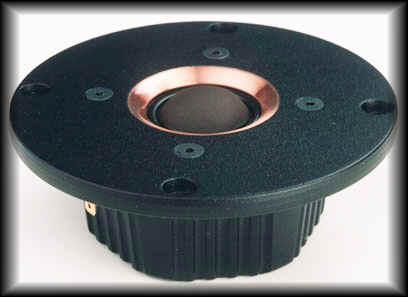 .
.

A few words on
enclosure design..
Designing an enclosure for ARCOS X is
surely an ambitious process with challenging issues. Let us have a look on them :

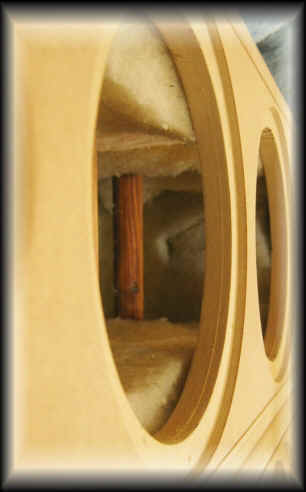
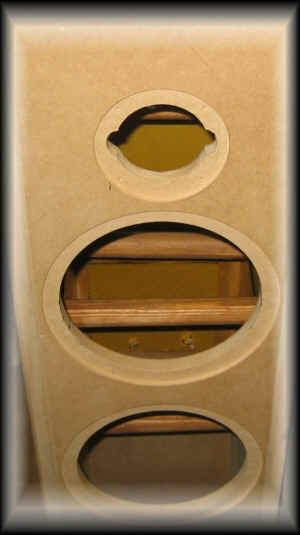
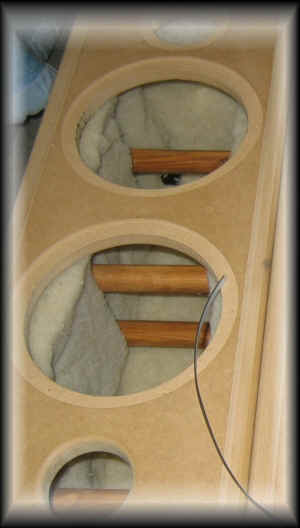
|
 |
MMT
configuration (lower Midbass, upper Midbass, Tweeter) for excellent placement of musical
instruments on the vertical plane. For us in MTZ audio this configuration has proved its
superiority when stereo imaging comes first,
|
 |
optimization
of front baffle width of better focusing in the listening room,
|
 |
thorough
selection of the height of tweeter driver with respect to the nearby baffle edges for the
suppression of diffraction problems and early floor/ceiling high frequency reflectivity,
|
 |
use of
medium width (22mm) and increased particle density MDF for an adequately rigid enclosure,
quite capable of handling high level pressure surges of the enclosed sound waves,
|
 |
precision
woodwork for best driver mounting on speaker front baffle,
|
 |
optimized
driver and vent height selection for minimum internal standing waves and 'clean' vent
emission,
|
 |
use of
cylindrical rods inside the speaker cabinet leading to an increase in wall vibration
damping,
|
 |
use of 2
different sound absorbing materials acting in different levels : wooden wall
'passivation', effective mid/high frequency absorption and artificial volume increase for
an improvement of the low frequency cutoff of the speaker's SPL response,
|
 |
separate
speaker base including highly absorptive mounts.
|
|

Arcos-X in the
low-frequencies..
As in the case of the rest of the MTZ
audio speaker projects, the low frequency simulation software LFA was used for the design
of Arcos X enclosure. The optimum value of 77lt was deduced for the speaker's internal
volume, producing a low freq.cutoff at 35.4Hz.
Usually a cabinet design procedure aims
to the minimization of all secondary emissions/colourations from speaker cones and the
vent itself. These are actually unwanted resonances formed by the enclosed space formed
inside the walls of a speaker. They are always present since they are inherent to all
speakers.
This minimization is merely a matter of
careful selection of the drivers' and vent positions.
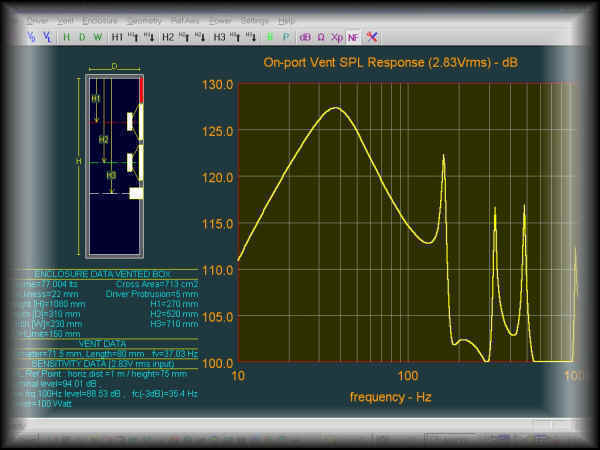
In the preceding figure the near field
SPL response of the vent is simulated by this software. Apart from the peak of the main
vent resonance at 37Hz, we can observe secondary emissions the level of which is kept as
low as possible due to optimized drivers' and vent positions on the front baffle. This
simulation has been carried out for a completely empty Arcos X enclosure (no absorbing
material). When all absorbing materials are put in place, low freq. colouration will be
further suppressed.
In the following picture the
measurement of vent SPL response of an assembled Arcos X speaker is illustrated.
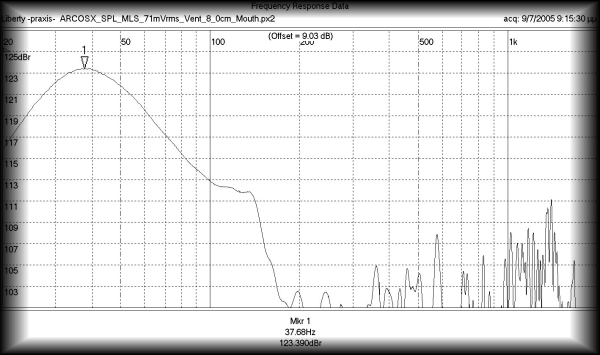
The success of the design procedure is
verified.

The crossover
circuit..
As expected the case of the Arcos X
crossover network was rather special. The woofer drivers featured a highly rigid magnesium
cone (thanks to which musical transients are reproduced in a much better way) having an
inherent SPL resonance peak at 5000 Hz.
Thus the crossover filters should not
only achieve a smooth cooperation of the phase responses of the acoustical low and
high-freq. branches (for a superior soundstage to be attained) but suppress in a selective
way the 4-5 kHz range of the low freq branch. Moreover a flat and resistive impedance
response should be achieved.
The circuit topology selected was not
complicated and when the optimization of component values came to an end, all targets were
fulfilled.
No need to say that hundreds of
listening hours were finally spent for elaboration and performance optimization.
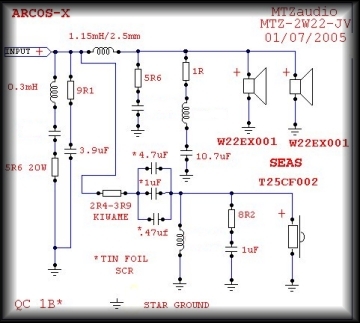
In the figure below the dashed curve
stands for the woofer SPL response. The resonance peak of the driver's magnesium cone is
concentrated at 5000 Hz. The normal curve shows the resulting low freq. SPL response as
filtered by the low-pass section of the crossover circuit.
The successful suppression of the
unwanted resonance as well as the spectral smoothing of the speaker response are more than
obvious..
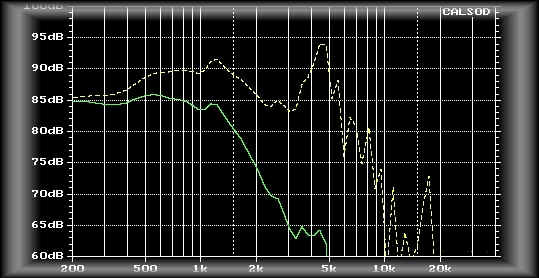
In order for Arcos X to merge its
response with the room's reverberant field, the speaker's anechoic response in the 1500 to
5000 Hz range was specially treated. Exhaustive listening sessions at very high SPLs were
utilized only to reveal an unexpectedly pleasant experience.
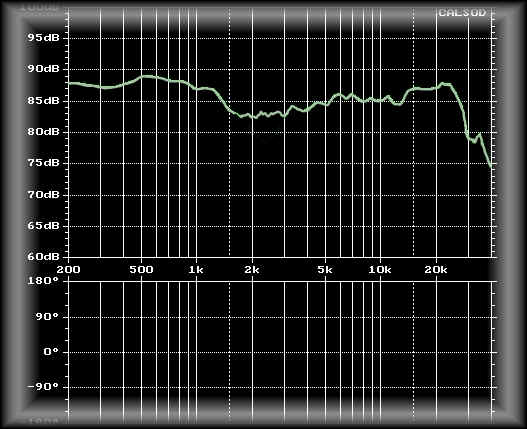
The picture above illustrates the
speaker's power response at a distance of 1m for a 2.83V rms electrical stimulus. Power
response is said to predict the sonic signature of a two-driver speaker in a typical
domestic room in a much more accurate way than the usual SPL response.
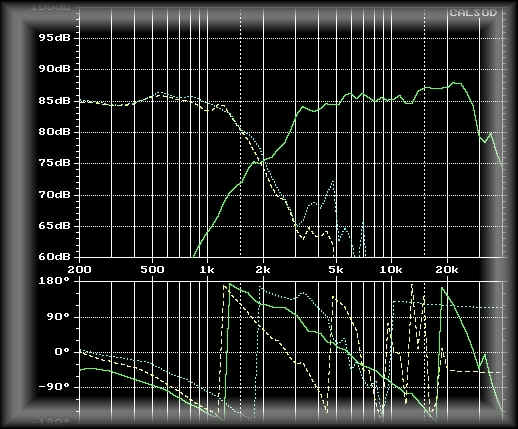
Finally the cooperation of the
speaker's acoustical branches (i.e. the low- and high-freq. sections) can be easily
determined by a close look at the picture that follows. It can be deduced that in
the overlapping or 'crossover' region the low-freq. branch exhibits an approx. 15dB/oct.
slope whereas the high-freq. one a smaller value of 11-12dB/oct.
Crossover freq. is approx. 2200 Hz.
Those who wish to examine the phase response will surely note that the tweeter's phase
(continuous curve) moves right in the middle of the phase responses of the two woofers
(dashed curves). The superior 3D focusing of the musical instruments and voices becomes
merely an inevitable result..
Since noone expects the listening rooms
to bear a significant degree of similarity, the Arcos X crossover topology includes a
resistor of unfixed value so that the DIYer can get the necessary wide range of adaptation
of the speaker's sonic signature to his/her room and/or personal taste.
In the recent years many DIYers have
been more and more engaged to the realization of a 'boardless' crossover, the 'hardwired'
one. In such projects ground-return paths are far better than those we can get on a pcb.
If we keep this in mind when we think of the large instantaneous electric currents of a
speaker then 'hardwiring' is definitely justified.
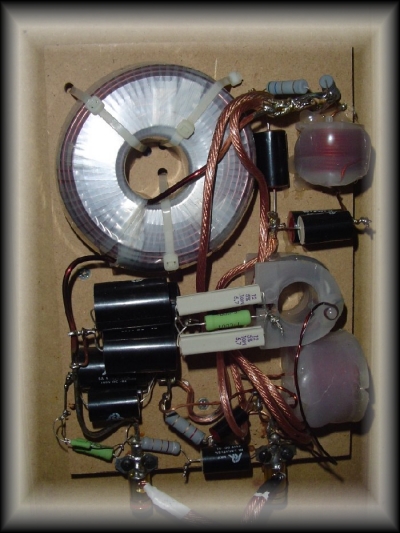
Naturally the details of such a
realization are quite many and critical. Yet MTZ audio eagerly provides (oral)
instructions that will satisfy all needs.
In addition several elegant housing
solutions are also provided. It is the customer to decide..
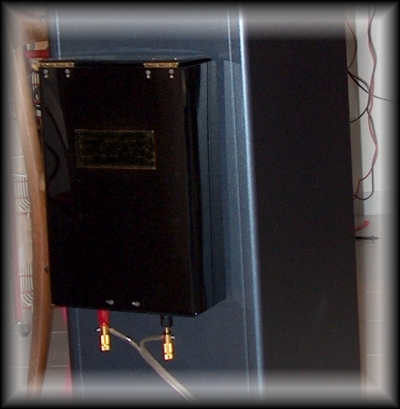

About loads and
complex speaker impedance..
The expression 'easy/hard' load is very
often used among audiophile enthousiasts. Some people define a speaker as an easy load for
an amplifier the one with high SPL sensitivity. At MTZ audio we understand that when it
comes to 'electrical loading', it is the range of instantaneous currents drawn by the the
amplifier and the problems induced to its power supply unit as well as its feedback
circuitry that really matter. It is only them that really drive an amplifier outside its
nominal steady-state power specs, raising perceptual differences between amplifier brands
and models.
Needless to say that this is an issue
too big to be discussed within a short presentation text. We therefore prefer to describe
our initial target concerning the impedance curve for the Arcos X speaker : flat and
purely resistive in a frequency range as wide as possible.
The actual curve obtained in the lab
and expressing this design philosophy is viewed in the following picture.
Impedance modulus only slightly
deviates from the 4 Ohm value even at frequencies well above the audible spectrum of 20kHz
! Its argument (which decides the achievement of pure resistivity) hardly exceeds the
positive or negative 5 degrees' value !
Listening to a pair of Arcos X speakers
driven by an amplifier bearing even a 'plain' power supply will certainly lead to very
interesting conclusions..
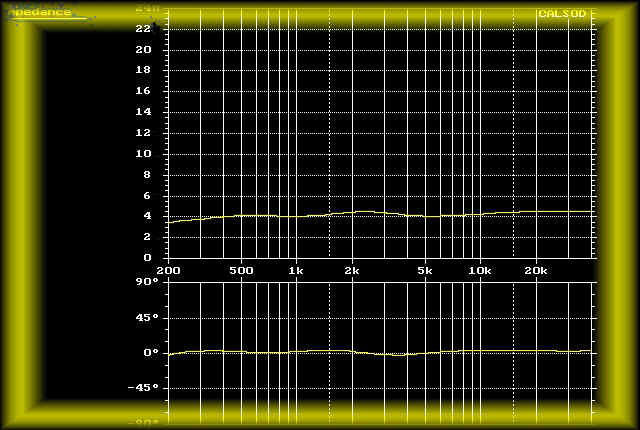
ARCOS X speaker kit
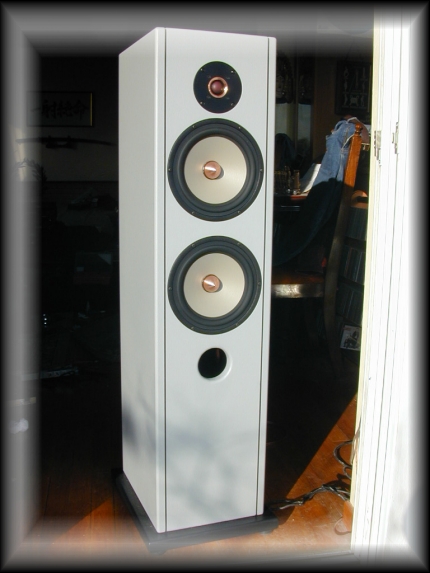
retail price of complete
speaker (pair) kit : 2510 euros
(19% VAT included)
Technical
Specifications
 two way,
three drivers' configuration (ÌÌÔ),
two way,
three drivers' configuration (ÌÌÔ),
 elegant
enclosure made of rigid 22mm-MDF, ready to be painted,
elegant
enclosure made of rigid 22mm-MDF, ready to be painted,
 bass-reflex design, tuning freq. at 37 Hz,
bass-reflex design, tuning freq. at 37 Hz,
 tweeter:
T25CF002, textile dome Sonotex, 25mm, SEAS,
tweeter:
T25CF002, textile dome Sonotex, 25mm, SEAS,
 woofers:
W22EX001, magnesium cone 8'', SEAS,
woofers:
W22EX001, magnesium cone 8'', SEAS,
 total
internal volume of 77 lt,
total
internal volume of 77 lt,
 exterior
dimensions in mm: 274x1124x354 (WxHxD),
exterior
dimensions in mm: 274x1124x354 (WxHxD),
 SPL
response (-6dB): 32Hz-30kHz,
SPL
response (-6dB): 32Hz-30kHz,
 SPL
sensitivity (50-1400Hz): 88dB SPL / 1m / 2.83Vrms input (anechoic),
SPL
sensitivity (50-1400Hz): 88dB SPL / 1m / 2.83Vrms input (anechoic),
 maximum
continuous power: 300W rms per channel,
maximum
continuous power: 300W rms per channel,
 maximum
instantaneous power: 500W peak per channel,
maximum
instantaneous power: 500W peak per channel,
 impedance
modulus: 4 Ohms (+/- 5 degrees above 180Hz),
impedance
modulus: 4 Ohms (+/- 5 degrees above 180Hz),
 crossover
frequency : 2.2 kHz.
crossover
frequency : 2.2 kHz.
 complete
speaker kit includes enclosures (unpainted cabinets), screws, damping materials, SEAS
drivers, crossover components, vent, cabling, speaker base with vibration-free mounts.
complete
speaker kit includes enclosures (unpainted cabinets), screws, damping materials, SEAS
drivers, crossover components, vent, cabling, speaker base with vibration-free mounts.
Drawings
Note : the following picture is a
link to a downloadable .pdf file.
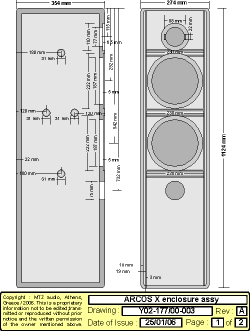
Some DIY
realizations of ARCOS X
The copyright of the following
photographs belongs to the owners of the illustrated speakers.
